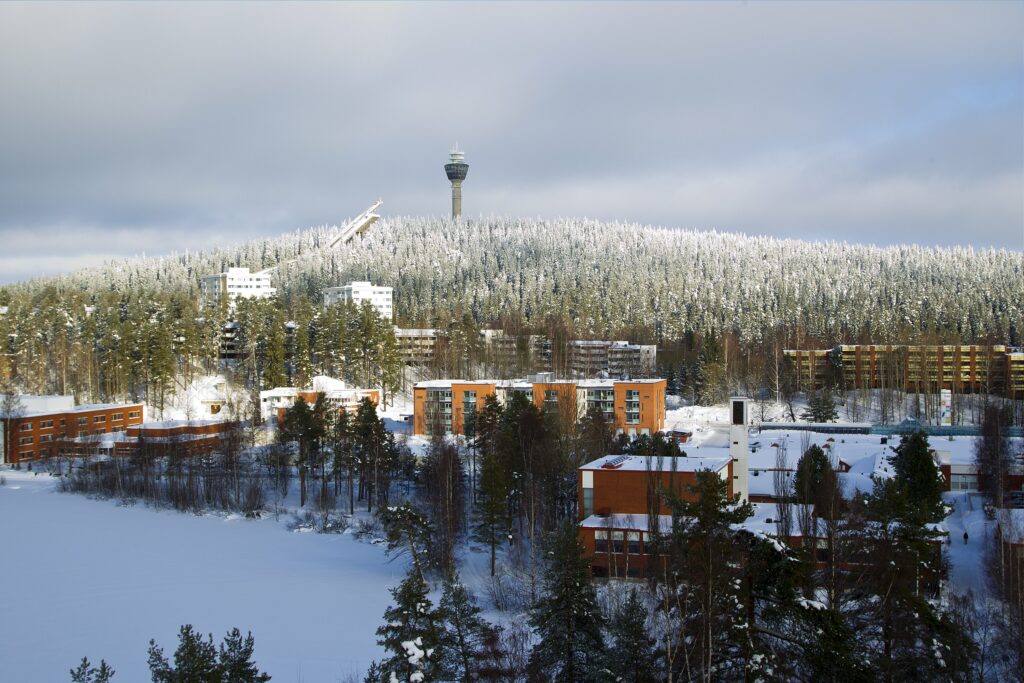History of Kuopio

In 1653, the Kajaani Convention established the City of Kuopio by permission of Swedish Governor-General Per Brahe the Younger. However, the official date of establishment of Kuopio in considered to be 17 November 1775, when King Gustav III of Sweden issued an order to establish the city as the capital of Savo-Karjala province and the place of residence for the Governor.
The name Kuopio has at least three different recorded origins. In the 16th century an influential person, Kauhanen, lived in Tavinsalmi. He changed his name to Skopa, and soon became colloquially known as Coopia and later Cuopio. Another explanation for the name is a Finnish verb ‘kuopia’, meaning ‘to paw’. During the time horses were common, the streets were full of potholes (‘kuoppa’ in Finnish), and when horses pawed the ground, they caused even more potholes. A third theory describes a person called Prokopij wandering from Ruokolahti to Kuopionniemi sometime during the Middle Ages. This Prokopij (a Karelian-orthodox name) most likely travelled in order to engage in trading. On the shore of Lake Kallavesi, he found a good place to trade, settled in, and gave his name to the region.
Railway and the Saimaa Canal improved transport connections
The period of Russian rule (1809–1917) was the time of development and emergence of fennophile interests. Particularly important for Kuopio and the whole of Eastern Finland was the crucial improvement in transport connections as the Saimaa Canal opened up a waterway connection to the sea and the Savo railway line, completed in 1889, facilitated access to the south.
Finnish culture created at Kuopio
Culture in Kuopio has a long history. The first trivial school in Kuopio was established as early as 1788. An upper secondary school was founded in 1844 and at the end of the 19th century, an industrial school, a business school, and a nursing school were established. Kuopio did not become an official university city until 1966, and at first the institution was called Kuopio institute of higher education (Kuopion korkeakoulu) until its name was changed into the University of Kuopio (Kuopion yliopisto) in 1984.
In the 19th century, Kuopio played a major role in the emergence of Finnish national consciousness and Finnish culture. The strengthened status of Finnish language, improved education, and the development of business life created a solid foundation for this emergence. A Kuopio-based headmaster J.V. Snellman began to publish a Finnish-language newspaper Maamiehen ystävä (lit. ‘Farmer’s friend’) in 1844.
At the end of the 19th century, Kuopio was the centre of Finnish cultural life, a place where music, literature, and arts could flourish. There were many people living in Kuopio, who had an indelible effect on Finnish history. These people include authors Minna Canth, Juhani Aho, and Maria Jotuni, as well as artists Juho Rissanen and brothers von Wright, or Family Järnefelt.
Independent Finland entering a new era
Finland’s path to independence and times of war affected the life in Kuopio in the first half of the 20th century, but at the same time the development impacting everyday living was gathering pace. The population of Kuopio started to grow rapidly at the beginning of the century, and the building of high stone houses created an urban atmosphere in Kuopio.
The spirit of the era was introduced to the city by, for example, motor traffic that began in the 1920s, and by various amusement opportunities that came with growing leisure time: the theatre, films, Väinölänniemi sports grounds, and Puijo ski resort. Kuopio city administration was also reformed and Kaarlo Salli was elected as the first mayor in 1929.
Bombings caused damage during the war
Wartime demanded sacrifices also in Kuopio. The city was bombed and grief over family members killed in action was known in many homes. After the war, Kuopio received many evacuees from Karelia, and with the birth rate also at its peak, the city’s population increased rapidly during the first years of peace, reaching already 30,000 in 1946.
Towards a modern city of technology and research
The end of the century was a period of rapid development. The majority of the rural municipality of Kuopio merged into the city in 1969 and Riistavesi in 1973, and by 2000, the population of Kuopio was 86,000. The city’s appearance changed as wooden buildings made way for more modern constructions, as suburban living became more common, and as supermarkets staked their claims at the centre and suburbs.
In 1966, a law was passed establishing a higher education institution (later university) in Kuopio. Teaching began in 1972, attracting a lot of young people and providing new opportunities for developing Kuopio. In business life, the service sector first became the most important employer, and towards the end of the century Kuopio clearly set out to become a city of modern technology and research.
In 2005, Kuopio reached the 90,000 resident mark as Vehmersalmi merged with the city. After that, Kuopio has seen more municipal mergers: Karttula with 3,500 residents in 2011, Nilsiä with 6,500 residents in 2013, and Maaninka with 3,700 residents in the beginning of 2015. The latest municipal merger with Juankoski in the beginning of 2017 increased the number of Kuopio residents with 4,800 persons. At the end of 2022, Kuopio has approximately 122,500 residents.